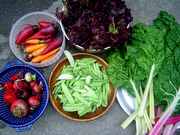

|
| Vegetable Varieties for Gardeners is a citizen science program
|
|
|
|
'Dark Purple Opal' Basil |
| |
| Sub-Category: |
|
| |
|
| Sub-Category 2: |
| | Description: |
Sweet basil plants reach 12 to 18 inches tall with mostly deep purple foliage and pale pink flowers. Small to medium size, tender leaves have a degree of licorice flavor that can be used fresh, dried or frozen. Developed at the University of Connecticut in the 1950's. 1962 All America Selection.
45 to 75 Days to Maturity.
|
 |
AAS Winner in the year 1962
|
| Days To Maturity: |
45-75
|
| Seed Sources: |
Baker Creek Heirloom Seeds - updated in 2014
|
| |
| Rating Summary |
| |
Overall: (3.5 Stars)
Taste: (3.0 Stars)
Yield: (3.5 Stars)
Ease/Reliability: (4.0 Stars) |
| |
| Reviews |
| |
Login to share your Review of Dark Purple Opal.
Number of Reviews: 2
KEY: O=Overall Rating, T=Taste, Y=Yield, E=Ease
Reviewed on 01/12/2015 by
CCEOnondaga
- An experienced gardener
|
 Overall Overall
 Taste Taste
 Yield Yield
 Ease Ease
|
Onondaga, New York, United States
Frost Free Season: 163 - 183 days
Soil Texture: Loam
Garden Size: Large - More than 1,600 square feet (40' x 40')
Sun Exposure: More than 8 hours per day
|
| Not quite as vigorous or aromatic as some of the other basils we've grown, but it grew well enough and certainly added a striking splash of color to the garden. |
| |
|
Reviewed on 11/27/2014 by
CCE Oneida County
- An intermediate gardener
|
 Overall Overall
 Taste Taste
 Yield Yield
 Ease Ease
|
Oneida, New York, United States
Frost Free Season: 163 - 183 days
Soil Texture: Loam
Garden Size: Medium - 400 square feet to 1,600 square feet
Sun Exposure: More than 8 hours per day
|
| Beautiful dark purple leaves and wonderful aroma; plants grew to about 2 feet tall and produced very well until heat of summer arrived, when they bolted. Flavor was similar to other basils, but not as strong, with slight hint of licorice. |
| |
|
|
|
|
Vegetable Varieties for Gardeners is a citizen science program, © 2004-2024, All Rights Reserved
Cornell Garden Based Learning, Cornell University College of Agriculture & Life Sciences, Horticulture Section
|







 VVfG home
VVfG home

